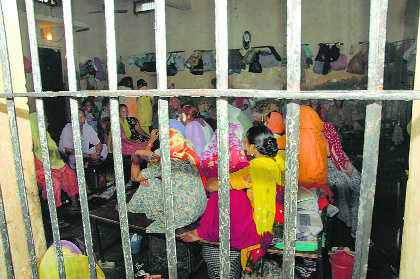
Elections matter. Australia voted, catastrophically, and immediately after suicide attempts and other forms of self-harm spiked among refugee and asylum seeker prisoners on Manus Island and Nauru. Elections matter. India voted, catastrophically, and the news for women inmates in prisons and jails across India is grim. The last five years of the Modi regime have meant ongoing and increasing violation of women prisoners’ rights, autonomy and well-being, on one hand, and a policy of increased opacity, on the other. In both instance, Australia and India, the State blames the women and children for the violence and torture the State visits upon their bodies and souls … and they call it democracy.
India went to the polls from April 11 to May 23. While it had little or no impact, the same week the elections began, the National Crimes Record Bureau, NCRB, finally released its Prison Statistics India 2016 Report. That report came in after an unexplained years’ long delay. The Prison Statistics India 2015 Report was issued in a timely manner in September 2016. The 2015 Report opens: “I am privileged to release the 21stedition of `Prison Statistics India’ for the year 2015, an annual publication of National Crime Records Bureau since the year 1995.” In 1996, the National Crime Records Bureau was tasked with publishing an annual report on the conditions in India’s prisons and jails. For 21 years, it did so, dutifully and faithfully. And then … it stopped. This silence concerning the conditions of prisons, jails and, most importantly, prisoners was matched by an equivalent “failure” by the NCRB to publish its annual Crime In India report for 2017. This was the first “failure” of this annual report since 1953. Taken together, the lack of reporting begins to look more like refusal than failure: “All this has happened on the watch of a government that is known for being less than forthright about official data.”
This refusal to provide detailed data continues throughout the Prison Statistics India 2016 Report. Most glaringly, the new report says nothing about caste or religion. Whereas earlier reports described, in detail, the situation and conditions in prisons and jails for Dalits, members of the Scheduled Castes and Scheduled Tribes, members of religious minorities, especially Muslim, this last `report’, the methodology of which is ostensibly the same as previous reports, says nothing. According to the most recent census, 16.6% of India is Dalit, while Dalits made up 21.4% of India’s prison and jail population. Likewise, Scheduled Tribes make up 8.6% of the Indian population and 12.8% of the prison and jail population. Many noted these discrepancies and strove to address them. The Modi regime has addressed them by erasing not only categories but whole sectors of the population. This is not failure to represent, this is refusal to represent, and it’s part and parcel of the caste and religion-based politics of the Modi regime and of his political party.
Where are the women in this picture? Everywhere and nowhere. Before the latest report came out, it was already known that prisons and jails in India are particularly damaging to women. First, they’re designed for men. Second, they have less access to facilities and resources within prisons and jails. Third, they have less access to resources outside of prisons and jails. For example, “a woman, nearly 70 years old, has been in jail for the past 18 months on kidnapping and rape charges … While five others, including two male co-accused, have been released on bail, she continues to be behind bars. Having lost her husband during her incarceration, she has no one to reach out to. What purpose is being served by keeping her inside?”
Further, over the preceding fifteen years, the rate of men’s incarceration has increased by 33%, while that of women has grown by 61%. Despite this growth of women’s incarceration, neither budgets nor infrastructure has increased. Thus, the women’s prisons are severely overcrowded and filthy; the food and hygiene are deplorable; and there is virtually no physical and mental health care. For Dalit and Adivasi women, the conditions are predictably worse. According to a recent study, “76% (279 prisoners) of prisoners sentenced to death in India belong to backward classes and religious minorities, with all 12 female prisoners belonging to backward classes and religious minorities.” None of this is in the most recent NCRB report.
The NCRB report does provide some data, and the most salient fact is that 67% of India’s prisoners are “undertrial”, meaning awaiting trial … meaning officially innocent. From 2014 to 2016, the number of undertrial, or remand, prisoners rose 3.6%, from 282,879 to 293,058 in 2016. Close to 71% of undertrial prisoners are deemed illiterate or low literate. While among convicted prisoners, prisoners 30 – 50 years old predominate, among undertrials the majority are 18 to 30 years old. 72% of women prisoners are awaiting trial. Much more than with male prisoners, women prisoners are overwhelming young, minimally educated, poor … and formally innocent. Additionally, there are 1,809 children in prisons and jails across India, and they all are cared for by their mothers, women prisoners. Of the 1809 children living behind bars, 78% of their mothers are awaiting trial, minimally educated, poor … and formally innocent.
Elections matter. Information matters. Transparency matters. Democracy matters. The United States “discovered” this week that a 10-year-old girl from El Salvador died in custody, last September, and that the State lied and hid that girl-child’s death. We are dismayed but not shocked or surprised. Refugee and asylum prisoners in Australia engage in increased self-harm and suicide attempts following the Australian national elections. Some are finally, in some cases after five-year delays, sent to the mainland for `care’. India cages more and more Dalit, Adivasi, Muslim young women and children, all formally innocent, and covers it in the civil equivalent of the fog of war. And we call it democracy.
(Photo Credit: The Tribune India)